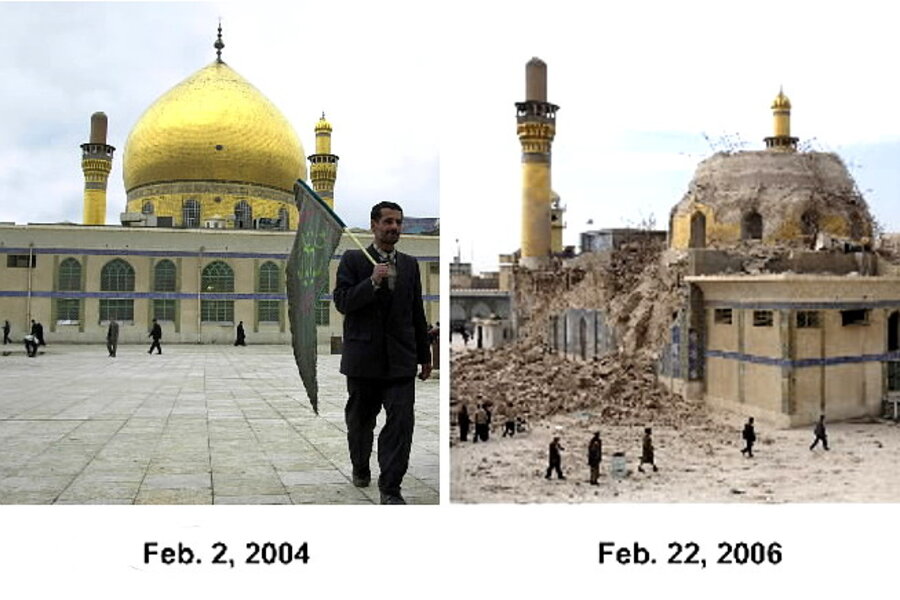Iraq's Samarra, site of Shiite shrines, could hold key to 'unity or chaos'
Loading...
| Washington
As US officials mull ways of preventing Iraq from descending into another bloody sectarian conflict – one that this time could spell the end of the state of Iraq – a key source of anxiety is the majority-Sunni city of Samarra, home to two of Shiite Islam’s most revered shrines.
Less than a decade ago, militants with what was then Al Qaeda in Iraq penetrated the security cordon protecting Samarra’s al-Askari Mosque with its famed golden dome and tombs of some of Shiite Islam’s holiest figures. The bombs of February 2006 destroyed the golden dome – and incited months of sectarian violence that plunged Iraq into more than two years of civil conflict.
Now with Sunni insurgents led by forces of the Al Qaeda-inspired Islamic State of Iraq and the Levant (ISIS) having taken control of parts of Samarra, and with ISIS leaders declaring their intent to destroy the city’s Shiite shrines, US officials are focusing on Samarra as a kind of sea wall holding back a potential tsunami of sectarian bloodletting.
“Everyone understands that Samarra is an important line,” Secretary of State John Kerry said Monday while on a visit to Baghdad. “Historically, an assault on Samarra created enormous problems in Iraq,” he added, noting that President Obama and his security team are closely watching events in the key trigger point.
The lighting of Iraq’s sectarian fuse in Samarra, which lies about 80 miles north of Baghdad, “is something that we all do not want to see happen again,” Mr. Kerry said.
On Tuesday, news from Iraq was dominated by conflicting reports on the fate of the major oil refinery in Baiji in northern Iraq. Early reports claimed that after more than a week of fighting at the refinery, Sunni insurgents had taken control of the facility. But by the end of the day Iraqi officials insisted that the refinery, which supplies the country with much of its domestic fuel needs, remained under Iraqi control.
The loss of the Baiji refinery to militants would be a severe blow, but it would not pose the same kind of mortal threat to a unified Iraq that destruction of the Samarra shrines would.
US officials traveling with Kerry say there is “no question” that ISIS, which has swept through much of northern and western Iraq in recent weeks with the assistance of anti-government Sunni insurgents, has both the “aspirations” and the “capabilities” to destroy the Shiite shrines of Samarra and other Iraqi cities.
Iraq’s holy Shiite sites were protected even under the regime of Saddam Hussein, a Sunni Arab dictator ruling over a majority-Shiite country. But the extremist ISIS militants follow a severe and austere form of Sunni Islam that rejects the Shiites’ attention to adornment and reverence for shrines dedicated to holy figures.
With the ISIS militants virtually erasing Iraq’s border with Syria, the fighting in Iraq is already threatening to evolve into a regional conflict. Underscoring that point were the Syrian jets that for the second day in a row Tuesday bombed sites in western Iraq.
But any attacks on the Samarra shrines would almost certainly prompt deeper intervention in Iraq by Shiite Iran, which according to some reports has already sent personnel to help protect the holy Shiite sites of Najaf and Kerbala in southern Iraq. And Iran’s intervention could prompt nearby Sunni powers, including Saudi Arabia and the Gulf states, to jump into the Iraq conflict on the side of the country’s Sunni tribes, some regional experts say.
As Kerry suggested by his pointed words in Baghdad, US officials are keenly aware that conditions in Iraq today are uncomfortably similar to those that were in place when Al Qaeda in Iraq struck in Samarra.
In February 2006 the Iraqi government was at a delicate moment in the process of putting together a government representing the country’s major sectarian communities. Today Iraq is also in the process of forming a new government, and Prime Minister Nouri al-Maliki is under pressure to throw off his old sectarian ways and draw in the Sunnis he has marginalized – or face a disintegrating country.
Shortly after the Samarra bombings of 2006, an alarmed President George W. Bush warned that the violence risked plunging Iraq into civil war, and he declared to Iraqis that “the choice is chaos or unity.” Two years of sectarian fighting followed.
Eight years later President Obama employed similar words as he announced plans last week to send 300 military advisers back to Iraq.
Either Iraq’s leaders “rise above their differences and come together” to “govern with an inclusive agenda,” he said, or the region will once again be confronted with “an Iraq in chaos.”








